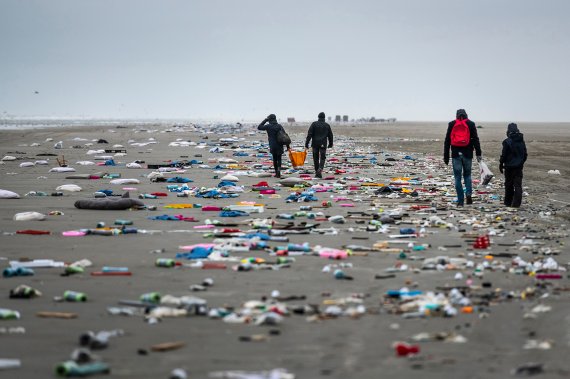text Roelof Kleis photos Kees van de Veen/Hollandse Hoogte
‘Great!’ was Martin Baptist’s first reaction when he heard on 2 January that the container ship MSC Zoe had lost some of its cargo to the north of the Wadden Islands. ‘I live on Texel,’ says Baptist, a scientist at Wageningen Marine Research, apologetically, ‘So beachcombing is in my blood.’ His second reaction was the more ‘professional’ one of a marine ecologist. He examined the facts and quickly ascertained that ‘fortunately the incident could have been much worse’.
‘The rest of the world immediately started talking about a container disaster. But it wasn’t an ecological disaster. If that had been the case, there would have been wide-scale ecological effects on flora and fauna, and we were spared that.’ At least, as far as we know. Baptist and his colleagues will do more research in the coming months, which should make things clearer.
We’ve become aware of the enormous amount of stuff we ship all over the world
**Bleach
MSC Zoe lost 342 containers, a small proportion of the estimated 8000 containers that were on board. The ship is capable of carrying 19,000. Of the containers that sunk, two were carrying toxic materials: one contained lithium batteries and another bags of Perkadox, a bleach powder containing organic peroxide.
Baptist is concerned about the latter. ‘The container has been located in German waters, but it is still unclear whether it can be salvaged completely. Most containers have broken open because of the fall they sustained. One bag of Perkadox has already washed up in Germany. Of course the stuff gets diluted in the sea and it breaks down, but how quickly that happens in waters of 8 degrees? We don’t know.’
We’re talking about a total of three tons of dibenzoyl peroxide. ‘The contents of the packages could potentially pollute an area of water equivalent to a third of the IJsselmeer, to a concentration at which effects would be found in 10 per cent of all invertebrates. On top of that, the stuff is very toxic to fish.’

Martin Baptist of Wageningen Marine Research is the coordinator of the Zoe research.
**Shoes and toys
In addition to the toxic cargo, most of what went overboard was consumer goods. Shoes, clothes, mattresses, flat screens, fleece blankets, plastic toys, car tyres, garden furniture, freezers and more. Baptist: ‘A small amount of goods have washed up on the beaches, but there’s much more lying on the sea floor and most of that is plastic. But we don’t have much detail about the cargo. The bills of lading that we have obtained only list broad categories.’
The ministry of agriculture and Rijkswaterstaat have commissioned Baptist and his colleagues in Den Helder, IJmuiden and Yerseke to make an inventory of the effects of all the debris on marine life. They will do so mainly by intensifying ongoing research. For example, the distribution of plastic will now also be included in the studies on the shellfish population in the North Sea and Wadden Sea. And in the ongoing study of fishery by catches, some fish will be checked for plastic. Baptist continues: ‘In the course of a year we collect 9000 fish. Given that they’ve been caught anyway, you may as well open them up. That way we don’t need to kill more animals than necessary.’
In order to assess the effects on seals, the University of Utrecht will examine in detail the bodies of 15 dead seals that washed up on the eastern Wadden islands. ‘We will be given the stomachs and intestines so we can study the digestive tract. And the effects of the Zoe disaster on birds should become clear from the research on stormy petrels that Jan Andries is conducting from Franeker. Baptist: ‘We’ll step up the collection of birds by volunteers on the eastern Wadden Islands. In addition, sea ducks (common scoters) are also being collected.’
**Increased awareness
The Zoe accident has not only created extra work; in Baptist’s view it has also resulted in increased awareness. ‘It’s made us aware of the enormous amount of stuff we ship all over the world’s seas. 130 million containers every year! And as far as I’m concerned, there’s definitely a lesson to be learned here: we need to have access to a detailed list of the cargo much faster. It’s now sixteen weeks since the accident and the details have still not been released. If you want to assess the ecological risks, you have to have the information much more quickly. The containers could contain anything.’
| Zoe incident in figures | 342 sea containers | That’s about 14 times as many containers than fall overboard in Dutch coastal waters each year (25) and a fifth of the total number of containers that are lost at sea each year (1700). About 130 million containers are shipped over the world’s seas annually. |
|---|---|---|
| 2736 tons (plastic) goods | Of this amount, 1100 tons have now been salvaged. Worldwide, between 4.8 and 12.7 million tons of plastic disappear into the sea each year. The Zoe cargo – much of which was plastic – represents 0.02-0.06 per cent of that. | |
| 3000 kilos dibenzoyl peroxide | One container that sank was carrying 280 bags of Perkadox, a bleach that contains this toxic substance. | |
| 700 tons steel | The containers are made of steel. The salvage operation is still underway. So far just under half of them have been lifted. |
Zoe’s zooi houdt ecologen bezig
Zoe’s zooi houdt ecologen bezig

